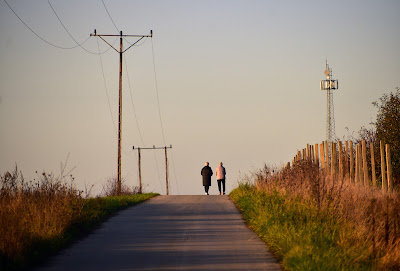Level crossings play their part in the aesthetics of railway travel. Every now and then, the regular rhythm of local comings and goings is disturbed by the clanging of bells, flashing of red lights and the dropping of barriers, announcing the imminent arrival of a train. The lights and bells begin more than three minutes before the train comes through, the barriers descend soon after. Few drivers bother to switch their engines off (it would save 2,400 revolutions of the typical engine idling at 800rpm - for a car with a two-litre engine that's 4,800 litres of emissions cut out, not to mention reduced fuel consumption and wear and tear on the cylinders). The train passes, the barriers rise, and several cars accelerate away.
With an instinctive knowledge of train timetables, it's possible to judge which times to avoid - or when to come and snap some photos. Chynów station experiences a rush of trains around the half-past the hour mark, both local and express services passing both ways.
Now the Warsaw-Radom line is complete, nearly all ungated level crossings have been upgraded to the latest standards, even pedestrian-only crossings, such as the ones at Ustanówek or Krężel have little barriers and flashing lights. This makes things safer for local traffic. Accidents at level crossings are mercifully falling thanks to the EU-funded railway modernisation programme.
Darkness falls early; all the commuter trains to and from Warsaw pass through Chynów at night. Now's the time to get night shots from the local level crossings.
Below: the crossing between Chynów (in the foreground) and Węszelówka (across the tracks). A double-decker przyspieszony (literally 'rushed' or 'hurried') limited-stop Koleje Mazowieckie train on its way to Skarżysko-Kamienna via Radom. When running to time, this services gets from W-wa Śródmieście to Chynów in just 39 minutes.
Below: the crossing between Chynów (foreground) and Widok across the tracks. In the distance, the lights of Chynów station. The passing train is the Koleje Mazowieckie all-stations service from Warsaw to Radom. It's often late as it has to make way for prioritised express trains, being held at stations with an extra track - Piaseczno, Czachówek Południowy, Chynów or Warka on this stretch.
Below: the crossing between Widok (foreground) and Chynów opposite. The InterCity express Orłowicz is on its way from Kraków to Olsztyn. This is the same crossing as the one above, taken minutes later from the other side of the tracks. In the distance, the lights of Chynów station.
Below: the crossing between Jakubowizna (foreground) and Chynów on the other side. A loco-hauled InterCity express, the San, bound for Przemyśl rushes through, approaching Chynów station.
This time seven years ago:
Catesby Tunnel
This time nine years ago:
Crumbling King Coal, Katowice
This time ten years ago:
Street cries of Old Poland
This time 11 years ago:
The gorgeousness of Warsaw at dusk
This time 12 years ago:
I'm so glad I'm living in Warsaw
This time 13 years ago:
Candid photography
This time 14 years ago:
Archival photos of Jeziorki's Rampa in action
This time 15 years ago:
Red sky in the morning...










































